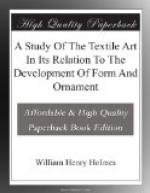All those agencies pertaining to man that might be supposed important in this connection—the muscles of the hand and of the eye, the cell structure of the brain, together with all preconceived ideas of the beautiful—are all but impotent in the presence of technique, and, so far as forms of expression go, submit completely to its dictates. Ideas of the beautiful in linear geometric forms are actually formed by technique, and taste in selecting as the most beautiful certain ornaments produced in art is but choosing between products that in their evolution gave it its character and powers, precisely as the animal selects its favorite foods from among the products that throughout its history constitute its sustenance and shape its appetites.
* * * * *
Now, as primitive peoples advance from savagery to barbarism there comes a time in the history of all kinds of textile products at which the natural technical progress of decorative elaboration is interfered with by forces from without the art. This occurs when ideas, symbolic or otherwise, come to be associated with the purely geometric figures, tending to arrest or modify their development, or, again, it occurs when the artist seeks to substitute mythologic subjects for the geometric units. This period cannot be always well defined, as the first steps in this direction are so thoroughly subordinated to the textile forces. Between what may be regarded as purely technical, geometric ornament and ornament recognizably delineative, we find in each group of advanced textile products a series of forms of mixed or uncertain pedigree. These must receive slight attention here.
[Illustration: Fig. 325. Coiled basket ornamented with devices probably very highly conventionalized mythological subjects. Obtained from the Apache—1/8.]
Fig. 325 represents a large and handsome basket obtained from the Apache. It will be seen that the outline of the figures comprising the principal zone of ornament departs somewhat from the four ruling directions of the textile combination. This was accomplished by increasing the width of the steps in the outline as the dark rays progressed, resulting in curved outlines of eccentric character. This eccentricity, coupled with the very unusual character of the details at the outer extremities of the figures, leads to the surmise that each part of the design is a conventional representation of some life form, a bird, an insect, or perhaps a man.




